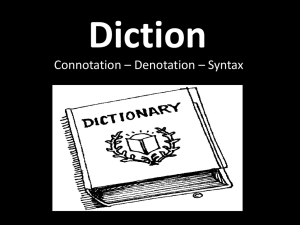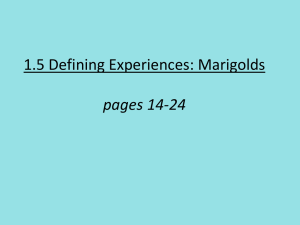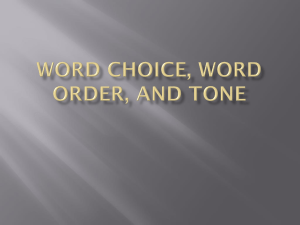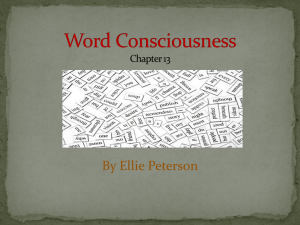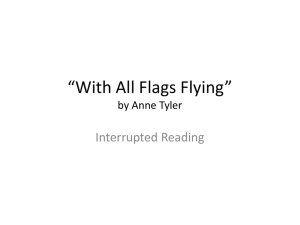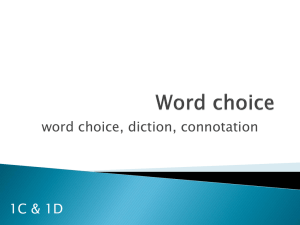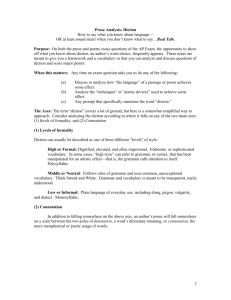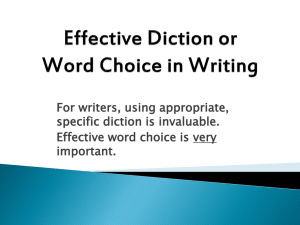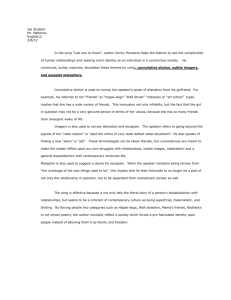Lesson 5 Talking About Voice & Narrative Voices
advertisement
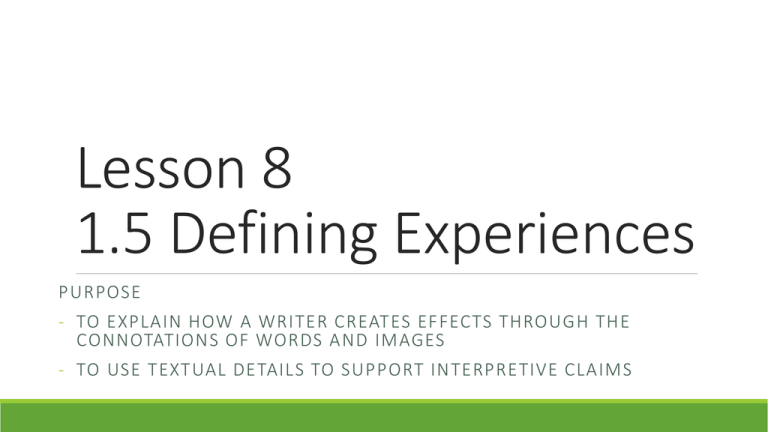
Lesson 8 1.5 Defining Experiences PURPOSE - TO EXPLAIN HOW A WRITER CREATES EFFECTS THROUGH THE CONNOTATIONS OF WORDS AND IMAGES - TO USE TEXTUAL DETAILS TO SUPPORT INTERPRETIVE CLAIMS Bell Ringer Diction, Denotation, Connotation Define the following terms found on page 14 ◦Diction ◦Denotation ◦Connotation What does diction look like? Diction is word choice. When writing, use vocabulary suited for the type of assignment. Words that have almost the same denotation (dictionary meaning) can have very different connotations (implied meanings). Examples: Formal Diction Casual Diction are not angry aren't mad Slang (very informal) What makes the previous phrases similar? Different? ain't ticked Denotation vs Connotation How to remember the difference Denotation is the Dictionary Definition (literal) ◦Example: Home = the place you live Connotation is the emotional meaning attached to the word ◦Example: Home = a loving place where family resides OR a battle field of conflict Tying it together… Diction, Denotation, Connotation Connotations In the following sentences, choose between the words in parentheses to make the sentence have as negative a connotation as possible. The leader was his nation’s most (notorious, well-known, famous) advocate. Immigrants (thronged, flocked, swarmed) to the large cities. A (trim, skinny, slender) woman entered the room. The man was (inebriated, drunk, intoxicated). Where did you find that (outfit, get-up, attire)? Guided Reading pages 15-17 Groups of 3 One person will highlight Diction One person highlight Syntax One person highlight Imagery I’ll read chunks 1-10, stopping to discuss together What do we notice and focus about the story? What can you say about the narrator so far? Trio Read In your trios, read chunks 9-18, taking turns Continue looking at diction, syntax and imagery Discuss why the marigolds are so important; what do they represent? Graphic Organizer Separate sheet of paper – As a class, what evidence have you found about diction, syntax, and imagery? Section of text (Chunk Number) Quote Diction that conveys voice Imagery that conveys voice Syntax that conveys voice Lesson 9: Finishing “Marigolds” in Activity 1.5 WRITE AT LEAST ONE OF YOUR VOCAB WORDS ON THE BOARD DISSECT THE SUFFIX (IF ONE EXISTS FROM OUR LIST) AND IDENTIFY THE PART OF SPEECH Recap and Continue Where did we leave off in the story? Continue where we left off In partners, look for only Diction and Imagery now At end: How would this be a coming of age short story? Connotative Words Skim back through the story and identify words that have connotative meanings Write the word in the “my notes” section, and explain the effect in using the word instead of a denotative word What inferences can we make based on the connotative words about the speaker’s tone, character, or the significance of the event? Page 23: Diction and Imagery that Convey Voice Let’s work through each section of the story and add quotes with clear diction or vivid imagery that can help us understand the voice of the narrator How would you describe the narrator and her voice? Page 24, Writing Prompt In Class Write an essay in which you explain with textual support the voice of the narrator through diction and imagery. Through the voice of the narrator, use examples from the story to explain how this is a coming of age tale. Begin with a thesis statement: a sentence that clearly states what you are proving about the voice of the narrator. Use direct quotations from the text to support your answers. Include transitions and a concluding statement. Three paragraphs (5-7 sentences each)
